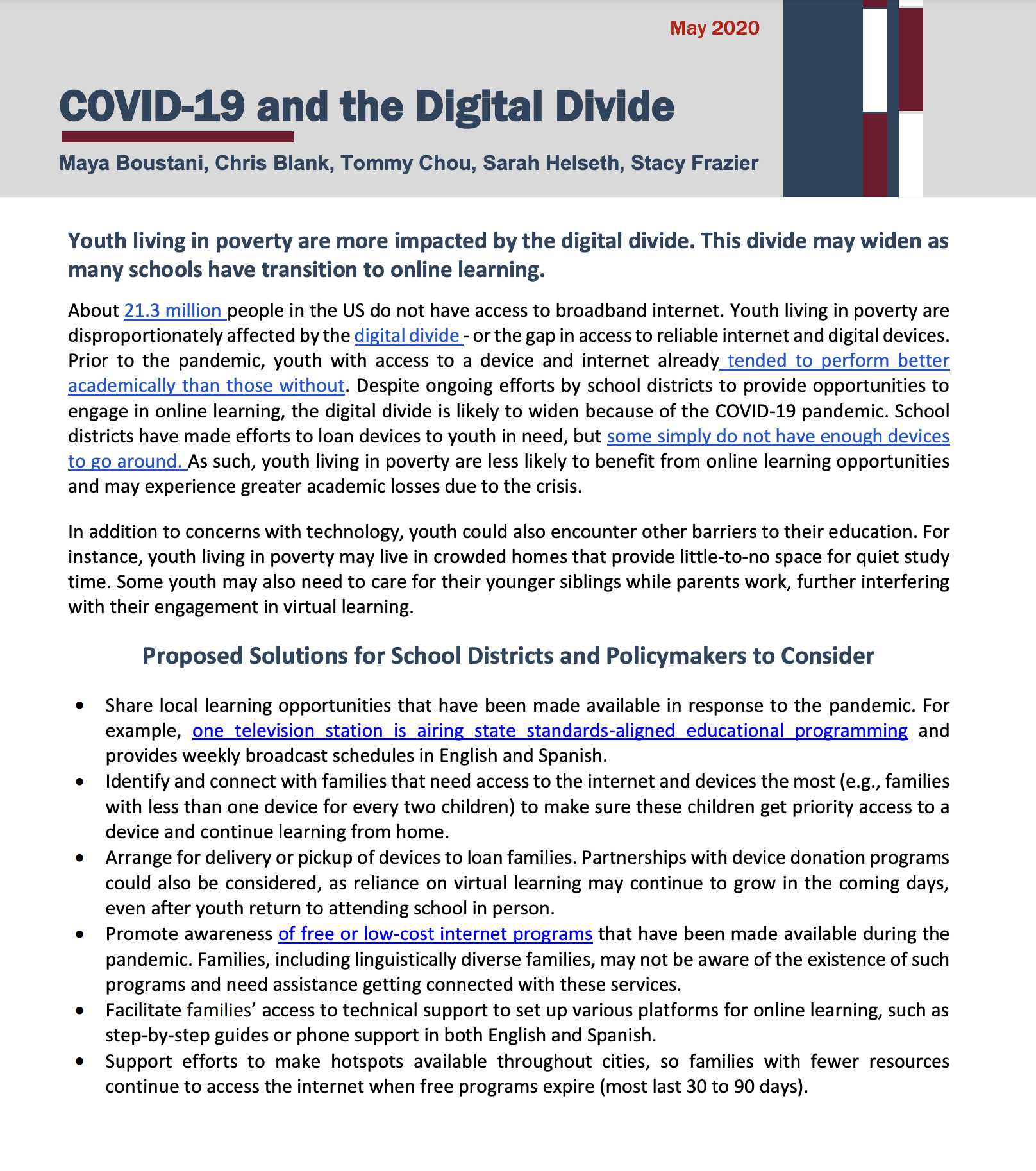
Youth living in poverty are more impacted by the digital divide. This divide may widen as many schools transition to online learning.
About 21.3 million people in the US do not have access to broadband internet. Youth living in poverty are disproportionately affected by the digital divide – or the gap in access to reliable internet and digital devices. Prior to the pandemic, youth with access to a device and internet already tended to perform better academically than those without. Despite ongoing efforts by school districts to provide opportunities to engage in online learning, the digital divide is likely to widen because of the COVID-19 pandemic. School districts have made efforts to loan devices to youth in need, but some simply do not have enough devices to go around. As such, youth living in poverty are less likely to benefit from online learning opportunities and may experience greater academic losses due to the crisis.
In addition to concerns with technology, youth could also encounter other barriers to their education. For instance, youth living in poverty may live in crowded homes that provide little-to-no space for quiet study time. Some youth may also need to care for their younger siblings while parents work, further interfering with their engagement in virtual learning.
Proposed Solutions for School Districts and Policymakers to Consider
- Share local learning opportunities that have been made available in response to the pandemic. For example, one television station is airing state standards-aligned educational programming and provides weekly broadcast schedules in English and Spanish.
- Identify and connect with families that need access to the internet and devices the most (e.g., families with less than one device for every two children) to make sure these children get priority access to a device and continue learning from home.
- Arrange for delivery or pickup of devices to loan families. Partnerships with device donation programs could also be considered, as reliance on virtual learning may continue to grow in the coming days, even after youth return to attending school in person.
- Promote awareness of free or low-cost internet programs that have been made available during the pandemic. Families, including linguistically diverse families, may not be aware of the existence of such programs and need assistance getting connected with these services.
- Facilitate families’ access to technical support to set up various platforms for online learning, such as step-by-step guides or phone support in both English and Spanish.
- Support efforts to make hotspots available throughout cities, so families with fewer resources continue to access the internet when free programs expire (most last 30 to 90 days).
The Research-to-Policy Collaboration (RPC) works to bring together research professionals and public officials to support evidence-based policy. Please visit their website to learn more.
Key Information
RPC Website
Research-to-Policy Collaboration
More RPC Resources
RPC Resources
Publication DateMay 1, 2020
Topic Area(s)Education and Child Development, Health
Resource TypeWritten Briefs
Share This Page
Youth living in poverty are more impacted by the digital divide. This divide may widen as many schools transition to online learning.
About 21.3 million people in the US do not have access to broadband internet. Youth living in poverty are disproportionately affected by the digital divide – or the gap in access to reliable internet and digital devices. Prior to the pandemic, youth with access to a device and internet already tended to perform better academically than those without. Despite ongoing efforts by school districts to provide opportunities to engage in online learning, the digital divide is likely to widen because of the COVID-19 pandemic. School districts have made efforts to loan devices to youth in need, but some simply do not have enough devices to go around. As such, youth living in poverty are less likely to benefit from online learning opportunities and may experience greater academic losses due to the crisis.
In addition to concerns with technology, youth could also encounter other barriers to their education. For instance, youth living in poverty may live in crowded homes that provide little-to-no space for quiet study time. Some youth may also need to care for their younger siblings while parents work, further interfering with their engagement in virtual learning.
Proposed Solutions for School Districts and Policymakers to Consider
- Share local learning opportunities that have been made available in response to the pandemic. For example, one television station is airing state standards-aligned educational programming and provides weekly broadcast schedules in English and Spanish.
- Identify and connect with families that need access to the internet and devices the most (e.g., families with less than one device for every two children) to make sure these children get priority access to a device and continue learning from home.
- Arrange for delivery or pickup of devices to loan families. Partnerships with device donation programs could also be considered, as reliance on virtual learning may continue to grow in the coming days, even after youth return to attending school in person.
- Promote awareness of free or low-cost internet programs that have been made available during the pandemic. Families, including linguistically diverse families, may not be aware of the existence of such programs and need assistance getting connected with these services.
- Facilitate families’ access to technical support to set up various platforms for online learning, such as step-by-step guides or phone support in both English and Spanish.
- Support efforts to make hotspots available throughout cities, so families with fewer resources continue to access the internet when free programs expire (most last 30 to 90 days).
The Research-to-Policy Collaboration (RPC) works to bring together research professionals and public officials to support evidence-based policy. Please visit their website to learn more.

Key Information
RPC Website
Research-to-Policy Collaboration
More RPC Resources
RPC Resources
Publication DateMay 1, 2020
Topic Area(s)Education and Child Development, Health
Resource TypeWritten Briefs
Share This Page
LET’S STAY IN TOUCH
Join the Evidence-to-Impact Mailing List
Keep up to date with the latest resources, events, and news from the EIC.




